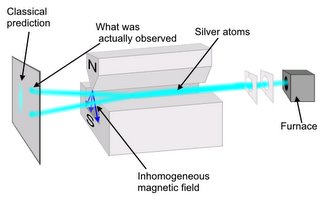
Today I started playing with a Stern-Gerlach demonstration experiment, which looks very much like the one above (thanks to Wikipedia). The one here runs with Potassium, though, and has an ionizing wire as a detector instead of photographic film.
The experiment is notable in at least two ways not usually mentioned. Firstly it was something of an accident that it worked at all. Trying to find the quantised orbital angular momentum predicted by the Bohr model, Otto Stern and Walter Gerlach chose an atom (Silver) which has zero orbital angular momentum, which was not predicted and could not be accounted for by Bohr's model. Fortunately enough they chanced upon the property of electron spin, although it took three more years for anyone to postulate spin, and another two for anyone to realise that Stern and Gerlach had measured it.
The other interesting point is that Otto Stern and Walther Gerlach, in a real-life homage to their famous experiment, went their seperate ways. Stern was part jewish and resigned from Hamburg university in 1933 to emigrate to the USA. Gerlach stayed in Germany and after working on Torpedos was put (officially) in charge of the nuclear weapons program. Fortunately for Gerlach and the rest of us, he seems to have been rather overwhelmed by the job. I quote from "the Virus House" by the controversial historian David Irving
Admirable though [Gerlach's] personal qualities were, he did not abound in energy and drive. Those who knew him then, and those who visit him now, retain an impression of an outstanding scientist imprisoned behind a desk heaped with reports, papers and documents through which he laboriously works, while never quite getting to the bottom. The calendars on his wall are over eight years old, the surface of his desk is seldom seen. Very soon the [Reichsforschungsrat] was sending [Gerlach] exasperated letters asking for the long-overdue bimonthly reports on nuclear physics to submit to [Hermann] Goering. They were met with a wall of silence from Gerlach's flower and plant bedecked Munich institute
In 1943 Stern received the Nobel prize in physics for "for his contribution to the development of the molecular ray method and his discovery of the magnetic moment of the proton". Gerlach has the distinction of being the eighth most nominated physicist to never receive a Nobel prize. Presumably Hitler's 1936 ban on Germans receiving Nobel prizes didn't exactly help his cause.
Stern and Gerlach both survived the war, continued their work as physics professors and met just the once afterwards.
Links:
Description of the experiment:
A complete history of the experiment:
A free download of "The Virus House" by David Irving, who may be a holocaust denier, but is one of the few historians who can speak german, understand physics and write entertaining prose.
Click Here
A very entertaining analysis of Nobel recipients, which reveals who the unluckiest physicist of all time is:
Click Here
1 comment:
There is also a interesting lecture by Samuel Goudsmit on the discovery of the electron spin which can be found here: http://www.lorentz.leidenuniv.nl/history/spin/goudsmit.html
Post a Comment